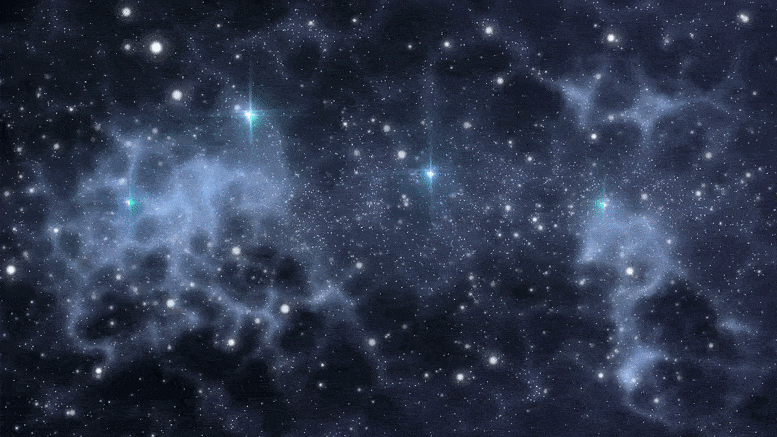
An unseen ‘mirror world’ of particles that interacts with our world only via gravity may be key to solving the Hubble constant problem, according to new research.
According to new research, an unseen ‘mirror world’ of particles that interacts with our world only via gravity might be the key to solving a major puzzle in cosmology today – the Hubble constant problem.
The Hubble constant is the current rate of expansion of the universe. Predictions for this rate — from cosmology’s standard model — are significantly slower than the rate found by our most precise local measurements. This discrepancy is one that many cosmologists have been attempting to solve by changing our current cosmological model. The challenge is to do so without ruining the agreement between standard model predictions and many other cosmological phenomena, such as the cosmic microwave background. Determining whether such a cosmological scenario exists is the question that researchers, including Francis-Yan Cyr-Racine, assistant professor in the Department of Physics and Astronomy at The University of New Mexico, Fei Ge, and Lloyd Knox at the University of California, Davis have been working to answer.
Cosmology is the scientific study of the large scale properties of the universe as a whole. It seeks to use the scientific method to understand the origin, evolution, and ultimate fate of the entire Universe. Like any field of science, cosmology involves the formation of theories or hypotheses about the universe which make specific predictions for phenomena that can be tested with observations. Depending on the outcome of the observations, the theories will need to be abandoned, revised or extended to accommodate the data. The so-called Big Bang theory is the dominant theory concerning the origin and evolution of our Universe.
According to NASA, cosmology is the scientific study of the large-scale properties of the universe as a whole. Cosmologists study concepts such as dark matter, and dark energy and whether there is one universe or many, sometimes called a multiverse. Cosmology entails the entire universe from birth to death with mysteries and intrigue at every turn.
Now, Cyr-Racine, Ge, and Knox have discovered a previously unnoticed mathematical property of cosmological models which could, in principle, allow for a faster expansion rate while hardly changing the most precisely tested other predictions of the standard cosmological model. They found that a uniform scaling of the gravitational free-fall rates and photon-electron scattering rate leaves most dimensionless cosmological observables nearly invariant.
“Basically, we point out that a lot of the observations we do in cosmology have an inherent symmetry under rescaling the universe as a whole. This might provide a way to understand why there appears to be a discrepancy between different measurements of the Universe’s expansion rate.”
The research, titled “Symmetry of Cosmological Observables, a Mirror World Dark Sector, and the Hubble Constant,” was published recently in the journal Physical Review Letters.
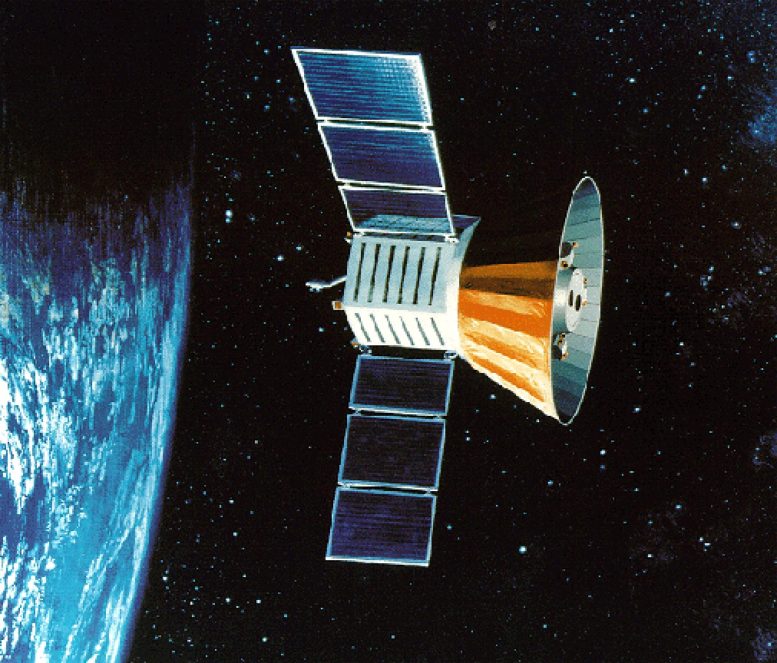
The COBE satellite was developed by NASA’s Goddard Space Flight Center to measure the diffuse infrared and microwave radiation from the early universe to the limits set by our astrophysical environment. Credit: NASA
This result opens a new approach to reconciling cosmic microwave background and large-scale structure observations with high values of the Hubble constant H0: Find a cosmological model in which the scaling transformation can be realized without violating any measurements of quantities not protected by the symmetry. This work has opened a new path toward resolving what has proved to be a challenging problem. Further model building might bring consistency with the two constraints not yet satisfied: the inferred primordial abundances of deuterium and helium.
If the universe is somehow exploiting this symmetry researchers are led to an extremely interesting conclusion: that there exists a mirror universe very similar to ours but invisible to us except through gravitational impact on our world. Such “mirror world” dark sector would allow for an effective scaling of the gravitational free-fall rates while respecting the precisely measured mean photon density today.
“In practice, this scaling symmetry could only be realized by including a mirror world in the model — a parallel universe with new particles that are all copies of known particles,” said Cyr-Racine. “The mirror world idea first arose in the 1990s but has not previously been recognized as a potential solution to the Hubble constant problem.
“This might seem crazy at face value, but such mirror worlds have a large physics literature in a completely different context since they can help solve important problem in particle physics,” explains Cyr-Racine. “Our work allows us to link, for the first time, this large literature to an important problem in cosmology.”
In addition to searching for missing ingredients in our current cosmological model, researchers are also wondering whether this Hubble constant discrepancy could be caused in part by measurement errors. While it remains a possibility, it is important to note that the discrepancy has become more and more significant as higher quality data have been included in the analyses, suggesting that the data might not be at fault.
“It went from two and a half Sigma, to three, and three and a half to four Sigma. By now, we are pretty much at the five-Sigma level,” said Cyr-Racine. “That’s the key number which makes this a real problem because you have two measurements of the same thing, which if you have a consistent picture of the universe should just be completely consistent with each other, but they differ by a very statistically significant amount.”
“That’s the premise here and we’ve been thinking about what could be causing that and why are these measurements discrepant? So that’s a big problem for cosmology. We just don’t seem to understand what the universe is doing today.”
Reference: “Symmetry of Cosmological Observables, a Mirror World Dark Sector, and the Hubble Constant” by Francis-Yan Cyr-Racine, Fei Ge and Lloyd Knox, 18 May 2022, Physical Review Letters.
DOI: 10.1103/PhysRevLett.128.201301

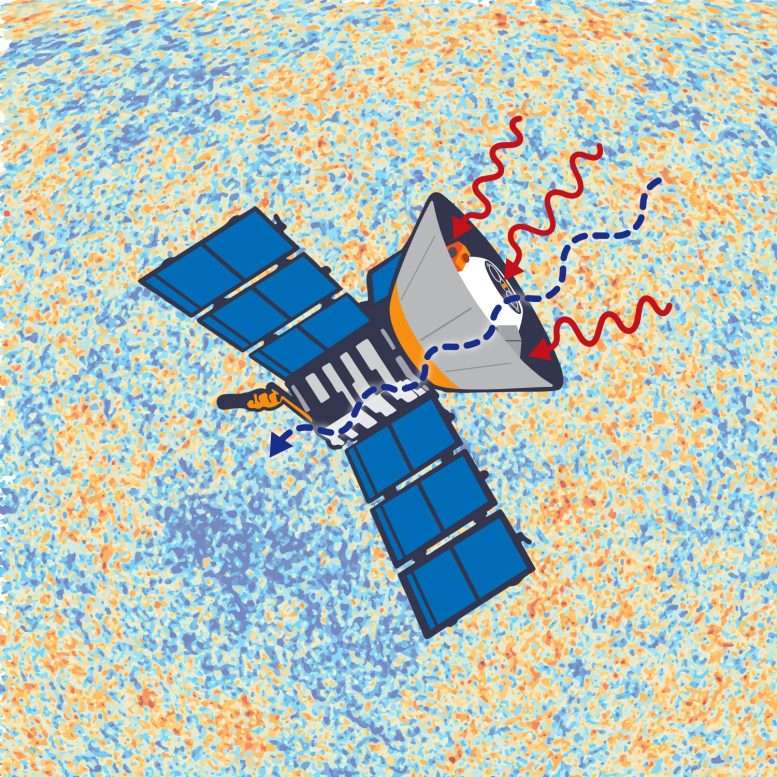
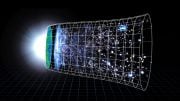
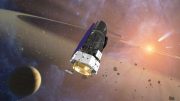
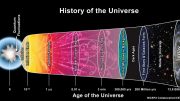
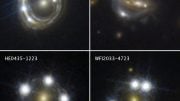
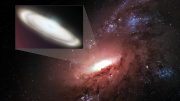
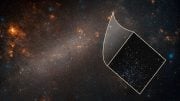
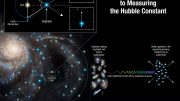
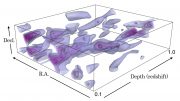
What? Here I thought that “science” was settled! Who knew?
Newtonian Mechanics, Classical Thermodynamics, Statistical Mechanics, Algebra, Calculus, Vector Space, Hilbert Space, Probability and Statistics, Electrodynamics, Fluid Dynamics, Special Relativity, General Relativity, Hamiltonian Action, Particle Physics, Quantum Mechanics, General and Organic Chemistry, Biology, Evolution, Computer Science, Psychology, Medicine …all additive and complimentary general categories of science, each with it’s own encyclopedias worth of experiments and measures, mathematical models, and theoretical constructs. Models and measures and mathematics, developed and refined over centuries, applicable in engineering and medicine, manufacturing and agriculture, churning out predictions and prescriptions, day after day.
What do you think your are talking about? Platitude may be the right word.
I can think of hundreds of things your aren’t. Science is specific. F=ma, e^iwt=sin(wt)-icos(wt), V=IR, E=hv, E=mc^2+pc, rho^2= Summation(x-bar-xi)^2/N and on and on the science goes.
What science, exactly?
Could the Hubble constant have changed?
LOL… Then it wouldn’t be a CONSTANT. This is a clear case of fitting the FOOT to the SHOE.
The HUBBLE BUBBLE burst 2+ Decades ago. IT’S BAAACK!
KEY QUOTE: “… UNNOTICED Mathematical Property…”
Hey guys! Watch me pull a rabbit out of my hat! It’s MAGIC! NOT-Science.
“It MIGHT work…”. YEP! In a FINITE, ONE-WAY TRIP UNIVERSE… where QUANTA are little “THINGEES”.
Lacking access to satellites and other advanced data tracking, I postulate the differences being observed are due to gravity not being a uniform value of space-time but, instead, pulsating angular lines of attractive force coiling, spiraling and radiating outward from all objects with mass. In my model of the universe it is the pulsating locally dense lines of gravity force which cause photons and electrons to appear as both particles and waves in double slit experiments. However, in deep space and as small and light as photons are, they probably tend to accelerate with expanding lines of gravity force as they leave their source and decelerate while penetrating more deeply into denser lines of gravity force arriving in our solar/planetary field. Include that rotating masses exhibit stronger gravity than still ones and there’s considerable reason for blue and red shift to be misinterpreted and the age and size of the universe to still be uncertain.
Intriguing
It’s almost like everything in the universe is connected to everything else in the universe in every way possible. Everything is a butterfly and even a tiny fraction can cause a galaxy to move.
LOL… Then it wouldn’t be a CONSTANT. This is a clear case of fitting the FOOT to the SHOE.
The HUBBLE BUBBLE burst 2+ Decades ago. KEY QUOTE: “… UNNOTICED Mathematical Property…”
Hey guys! Watch me pull a rabbit out of my hat! It’s MAGIC. NOT-Science.
“It MIGHT work…”. YEP! In a FINITE, ONE-WAY TRIP UNIVERSE… where QUANTA are little “THINGEES”.
I fully back this theory as a clear possibility as their should be no matter left after the Big Bang but if third was a twin anti universe with excess anti matter it would add up
I understand the temptation to cover scientific papers that propose solutions to a knotty problems, where the science writer gets to lay out the mystery and then solve it in the last paragraph, as long as things are in perspective.
I try to scan the arXiv astro-ph articles every day and by now there must be 100s of proposed solutions to the Hubble tension, with any one of them having about a one in a zillion chance of being right. The fertility on the subject might at least be pointed out to an unsuspecting public, lest they think more highly than they ought of the latest of very-many theories.
Humans can only see 1/6 of the universe. 5/6 is outside our timeline. That would explain the missing matter/energy.
“The mirror world idea first arose in the 1990s”
NOPE. Again that systematic error, made by all scientific popularization articles and even by researchers who publish on this very topic!
Such “mirror world” populated with symmetric particles, has been theorized and published first by Russian physicist Andrei Sakharov in 1966-1967! He called such mirror universe, with complete CPT symmetry, the “twin universe”. Sakharov worked in the field of elementary particles, and did not add gravity at that time. Later on, French physicist JP. Petit added gravity to the theory, introducing a first Newtonian model in the 1970s, that later evolved as a relativistic theory in the 1990s, then as a complete cosmological model : the Janus cosmological model. Find it on januscosmologicalmodel dot com and you’ll see all the historical developments and their implications.
Could the Hubble constant be a set of variables that differ by measurement technique?
When does a constant look like a variable? When it is measured over and over by different methods with consistently different results. So Hubble constant remains a constant with one method of measurement but shifts to a new answer when measured in a different way? Is this evidence we live in a quantum universe with results that change based on how we measure things?
I think everyone should consider re-reading Einstein. Objects farther away from the gravity well, experience time faster; objects closer, experience it slower. That applies to Galaxies, and even the Universe. It explains why both the stars closest to the center, and those farther away, orbit the Milky Way Galaxy in sync, and it explains why Galaxies farther away from the center are accelerating, relative to us. No Dark Matter, No Dark Energy, and No mirror Universe.
Instead of implicating fantastic scenarios of mirror universes and other unquantifiable solutions, why not explore simpler phenomenon. As the universe ages, gravity pulls mass (galaxies) into huge walls, clusters and filaments, which also creates low mass voids (Boötes void, for one). Since we are the oldest point within the universe, when we observe the rest of the universe we must view through these local voids which are naturally much less developed in the distant earlier universe. Could viewing the universe through these reduced gravity cosmic voids, which are prevalent in our local mature universe, skew our concept of the Hubble constant?
The obvious (to me, anyway) question is whether this would explain dark matter. Since that’s not mentioned, I suspect not.
Hubble is a composite.
The majority of it is simply the age of light; it gets red because it loses energy over time. Lost energy is seen in cosmic background radiation.
Yeah, no big-bang as we know it, sorry.
The discrepancy being seen is velocity red-shift from expansion, but is visible only now at extreme distances.
Ga = 2/3π DiameterDensityG – cosφ V^2/diameter
Is the Universe expanding in one direction, or all directions at once? And how do we see galaxies on the other side of the expansion?
Wow I’m like 99.9% sorry I read through these comments. Like I hope you were all drunk when you wrote these or are all in like 3rd grade idk I’m drunk and feel like I understand physics better than some of these guys lol. I’d love to break down my issue with each individual argument(I mean one comment asked if the expansion of the universe happens in a straight line or in all directions. Hold a granade and inform me if it just shot out from your hand please.) but I probably won’t remember I left this comment tomorrow peace.
Cosmology is definitely not “settled”, that’s for sure. I wish the respective scientists would let the common folk realize this, instead of making people think it is. Same with evolution, which isn’t even science. It’s become a religion, as well as multiverse theory. The definition of science has even changed.
. or maybe it’s not expanding at all, in fact we are shrinking .. wouldn’t it be possible we are being sucked into a black hole right now? then we would be in a state of shrinking and time stasis..